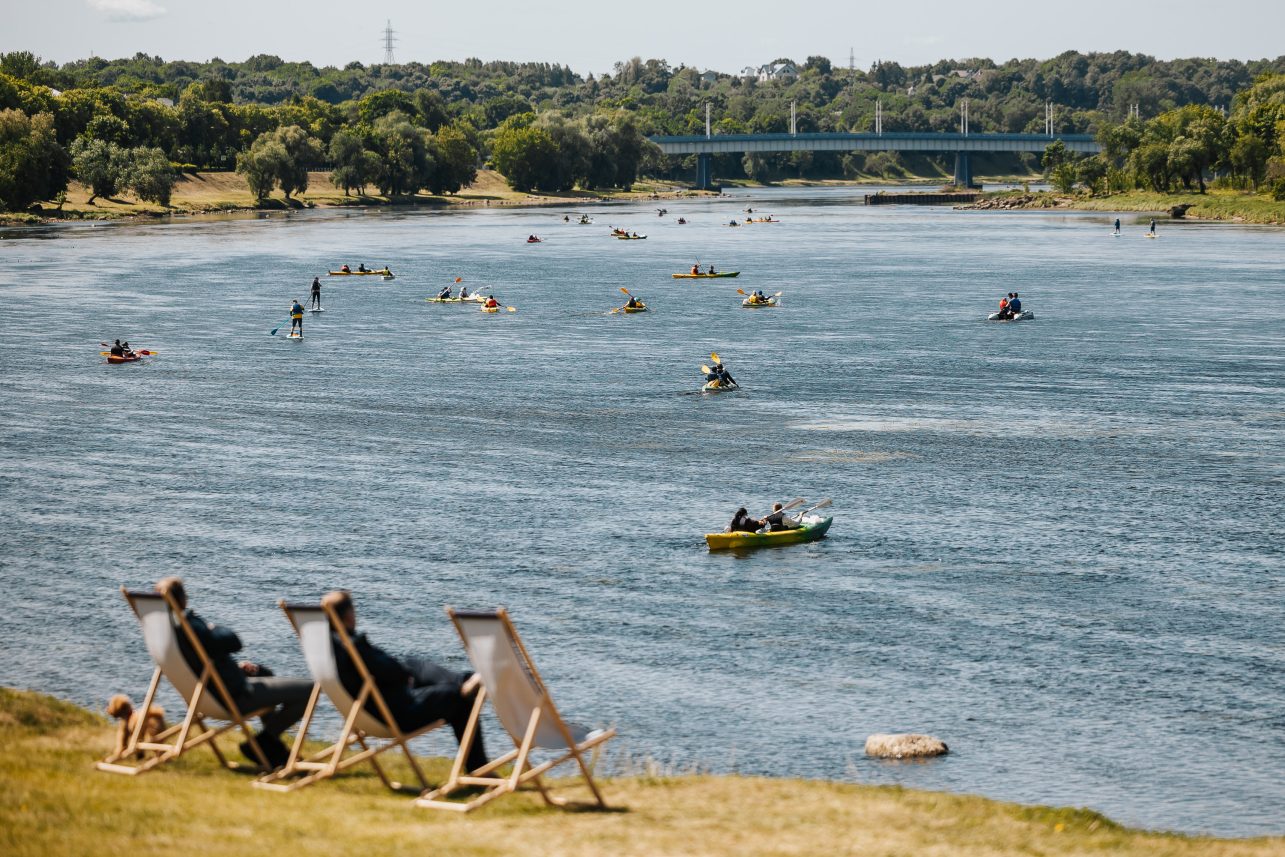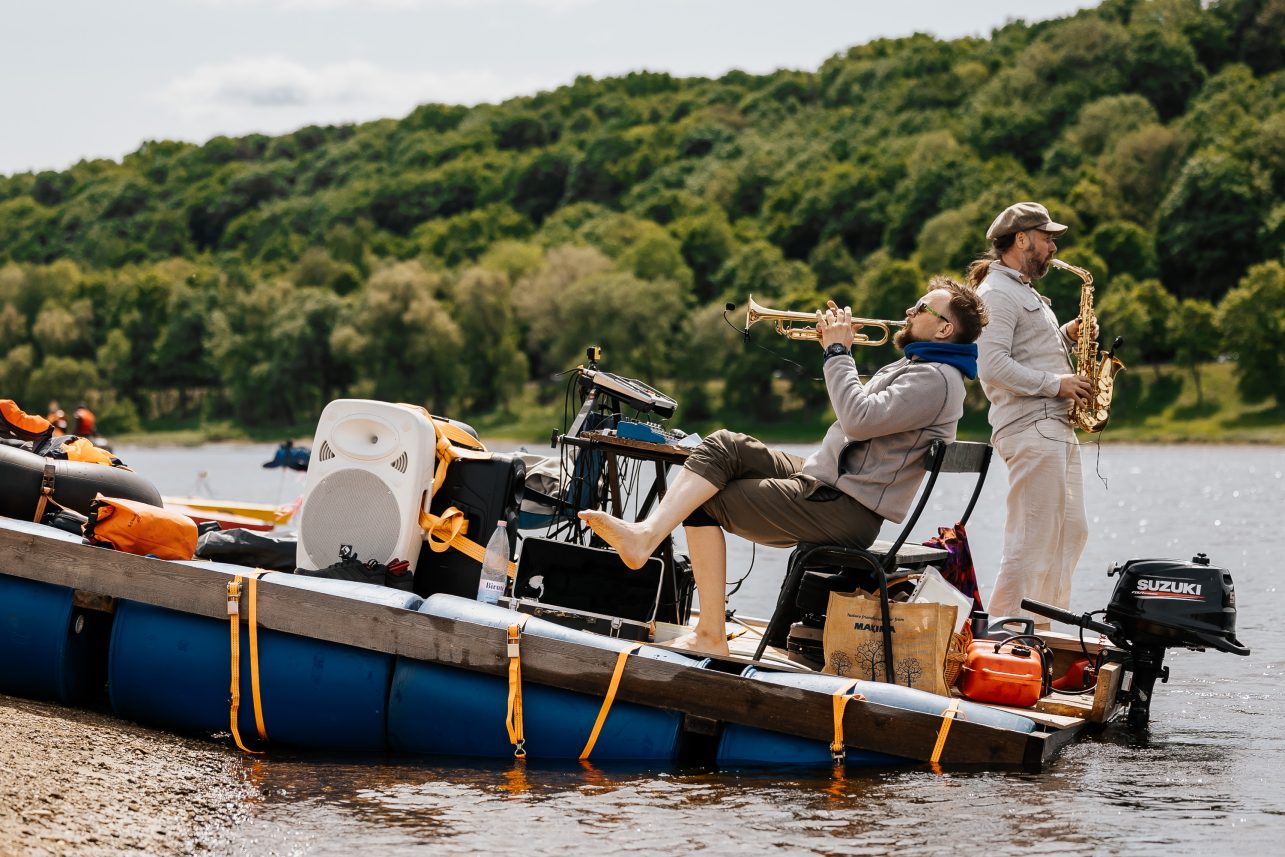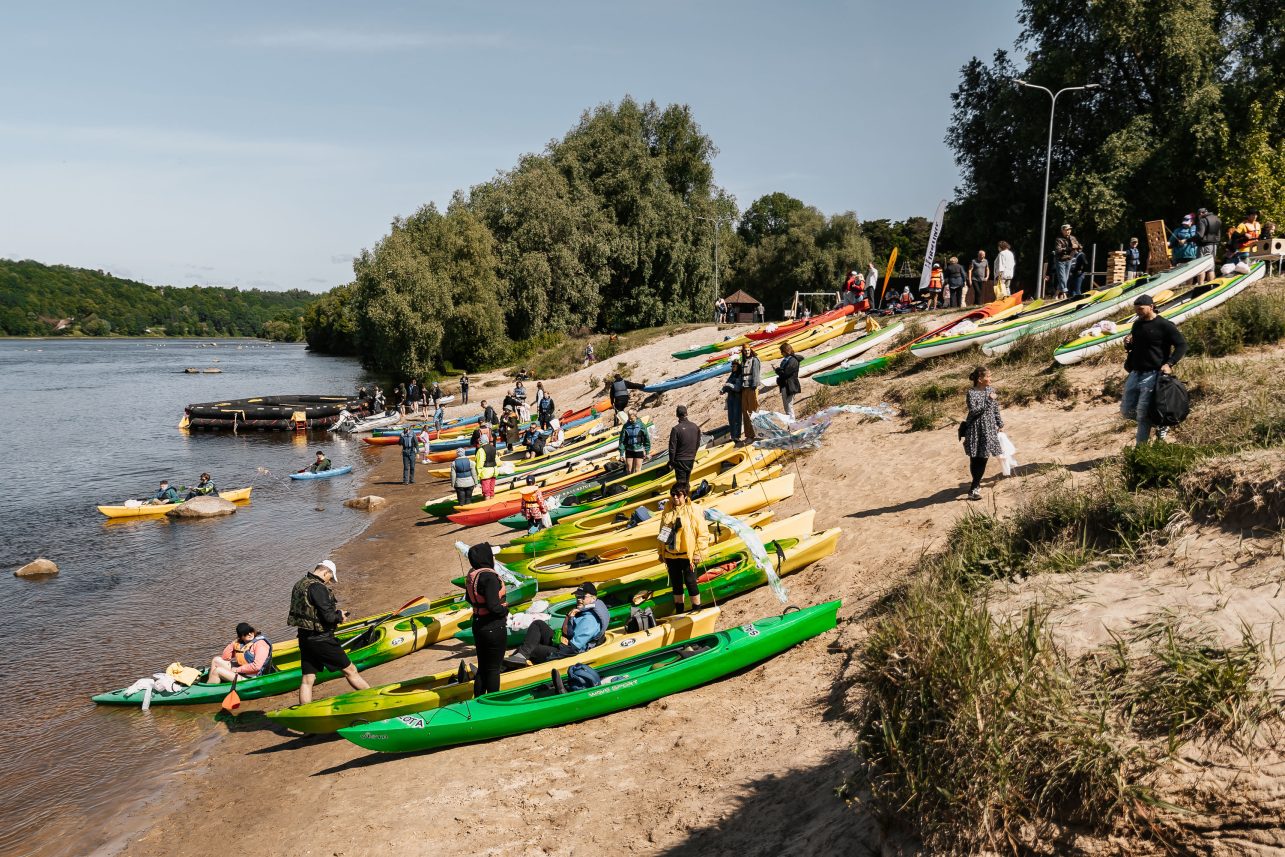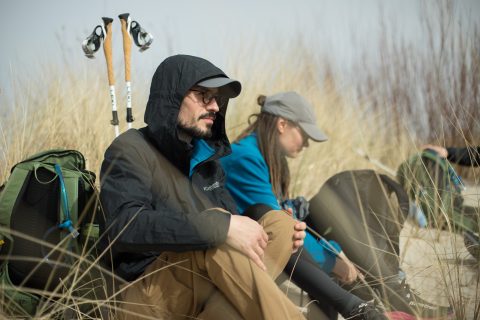It is important to return to the river, dip your feet in the water and, while looking at the current, understand that everything constantly changes. This is how Kaunas also changed – safely surrounded by the Neris and the Nemunas, the city was one of the largest river centers in the region and a lot of life was happening on the water (my colleagues’ texts about it can be found in the pages of this issue). Now, it seems, we have forgotten the culture of the rivers, and the riverbeds have also become shallower.
Let’s Celebrate the River! initiative invites you to turn to the water. It aims to experience the rivers through cultural routes in the water and on the shores, establish connections, enjoy the community, and remember or discover new river bends. The initiative culminates with an annual mass drifting down the Nemunas and/or the Neris. The riverbeds are filled with a bustling group of “sailors” and their kayaks, little boats, or homemade vessels. There is also plenty of activity on the riverbanks including cultural islands offering a program of different events. Co-creators of the event Romena Puikytė, Vitalija Kuršienė, and Gita Balžekaitė encourage making rivers a part of your everyday life transferring your hobbies, activities, communal and cultural ideas next to them. My interviewees told me that life on the river can surprise you with souvenirs that fall from the sky onto the raft or bunny rabbits boating with a suitcase full of carrots.

How did this idea, which has already become a tradition, come about?
Vitalija Kuršienė: 2020 we traveled by bus to Rijeka in Croatia, this city was then one of the cultural capitals of Europe, and we represented Kaunas there. During the trip, we discussed that we are worried about our rivers and want changes in this area. We came back full of ideas and organized our first boating event a few months later. When we promoted the ideas, like-minded people appeared. I am also surprised by the development of the initiative: we came up with the concept, organized the boating and the next year Let’s Celebrate the River! became one of the Kaunas’ birthday events and a year later it became an international event. We did not really dream of this growth.
Romena Puikytė: The main principles of the Fluxus Labas community program dedicated to the city’s districts served as a basis for the idea. They include experiencing adventure and culture in the city, DIY, and contributing to coordinating all of these things. Now we cooperate with the Kaunas Artists’ House. We can implement an event of this scale only with their help.
I remember the first boat trip on the Neris. It was on the day of the event that we received news that it was mandatory to wear masks, which brought a lot of confusion.
Vitalija: After that, we had the boat trip on the Neris and the Nemunas and this year it was only on the Nemunas. I always wanted to boat in just one river, so we could all celebrate together.
How did the idea that the river should be celebrated as a birthday or other occasion came about?
Romena: In the first year, we invited the townspeople to organize their own festivity. We also encourage cultural institutions to move their activities outside; back then, in 2020, it was still quite unusual. During Kaunas 2022, the idea of plein air painting came up: on the third Friday of July, we gathered on different banks of rivers to paint or draw. It’s also a fun tradition.
Vitalija: Boating on the river that runs through a city is quite relevant but often invisible. I remember swimming with a raft and people from the Panemunė pedestrian bridge shouted and waved in surprise, and finally, they threw a packet of chips into the raft. People were happy and shared what they had with me.
Gita Balžekaitė: I live next to the Neris, and I see how active the park along its banks is; it seems like rivers are a part of life. I wanted to attract more cultural, communal, and artistic activities to them. That is how cultural stops on land were born, which take place in parallel to boat trips on the river.
Romena: We organize other events by the river throughout the year: discussion stations, singing, workshops, plein airs and we invite people to look for new formats, to think; maybe your favorite activity can be moved to the river.

Among the large group of participants, some might be finding themselves in a kayak for the first time or boating on a wide river. How do you ensure security at the event?
Gita: Professional divers, who are traveling with us, help anyone in need, even if it means dragging a kayak or a raft down to the water. Life vests are mandatory.
Romena: Many people say before the event, “Let’s hope it doesn’t rain.”
But for me, the most important thing is that there is no strong wind because the rafts are carried fast, and they do not necessarily cover the planned route. By the way, it rains every year, but that’s fine because we return all washed and calm after the event.
I imagine that after the mass boating trip, the atmosphere is quite uplifting, and the river opens up in a completely new way. However, how should we integrate the celebration of the river into everyday life?
Vitalija: The three of us do not always agree. I would like to see recreational areas on the riverbanks that would not harm nature. They are currently lacking in the city, and a good example is the riverbank of Kauno dokas. I would also like to see more trees that reduce flooding.
Romena: I live near Santaka and there are very few trees there on the banks of the Nemunas. It seems that on hot days people stand and wait for their time in the shade. I also wanted to work with communities and discover marks of identity, so that the people living near the river could have a meeting point on the banks, for the small-scale architectural objects to appear. This year, we finally organized a land art plein air: the objects can be seen on three different riverbanks.
Vitalija: Vessels were actively navigating in Panemunė back in the day, so we created little boats, symbolizing the busy past of the river, and raised them on rods. Later, saving them from the flood, we placed them near the Panemunė library.
Gita: I live near a lively park and think that the river is a routine, a part of everyday life for many people. So, this initiative is exactly about that: let’s enjoy the river, and celebrate it, while actively inviting people to be closer to it and to notice it.
Returning to the rivers, we first encounter the banks, which don’t always bring us closer to the river. The banks are often built up with industrial or residential buildings, and the approaches are concreted or fenced off. How do you see river embankments?
Romena: Basic things are missing on the riverbanks: greenery and shade. I’m glad that in some places the meadows are not intensively mowed, they provide some coolness on the banks when the sun is too hot. Walking through it is very convenient. Of course, I dreamed that there would be more steps into the water to sit by the river. The life of the river could recently be experienced at the site of the future M. K. Čiurlionis concert center. There is so much life with the Old Town in the front; you can wade in the water or swim. While organizing the event, we also faced the problem of the Neris banks: It was a challenge to find spots that could be reached by car and where the kayaks could be unloaded.
In 2021 the creators of the TẽKA project said that the riverbeds of the city are so densely overgrown that people living or working nearby rarely realize that there is a river nearby. In 2022 a participant in your event expressed similar thoughts, “We saw that we can use the river, and how much joy and emotions it brings. We were surprised that we could be with the Nemunas or next to the Nemunas.” What effect does the river have on a person?
Vitalija: I have boated on many rivers, so the river is a road for me, and the river and the city are one unit. If the city’s streams were freed, they would beautify it greatly. Once we walked along the Veršvas stream with kids and one of them was quite uncomfortable, he was afraid that someone might attack us, but the other child reassured him that there were no people there because there was not even one trash around! So, I sometimes jokingly wish for some trash to appear.
Gita: Kaunas is extremely lucky to have two rivers. We get a lot from that: natural spots for rest and recreation, and patches of nature for animals and birds. I want nature to remain as less urbanized as possible.
Romena: The development of the city took place thanks to both rivers. I am interested in the historical context, and the river as a communication and cultural path. During the writing and drawing workshops, many people rediscovered the river and remembered their favourite spots near it. Flow is life. Until there were barriers on the embankment of Karaliaus Mindaugo Avenue, I felt like I was going for a walk with Nemunas.

How many people does your event draw?
Romena: We receive over 300 people who want to embark on a boating trip. The majority of people come to the event as a celebration, others want to have a quick boat ride as quickly as possible and move on. But this is not a race, there are no winners, and we try to include everyone.
Gita: There is poetry, modern dance performances, sutartinės, and other music for those who don’t raft or boat. About 1,000 people usually visit the cultural stops. Romena: The event is already known; we also hear the people of Vilnius saying that they also want to celebrate the river. Last year we had the idea to publish an open call for artists, and this year we received 40 ideas. It made us very happy, and the program immediately expanded, we couldn’t even accept everyone.
Vitalija: People are more inclined to receive, but we are happy when they come prepared. In the first year, two guys dressed in black suits and children’s rabbit masks were boating because we asked the participants to come with masks. They had an antique suitcase in their boat, and when we reached the finish line, we asked them what they had inside. They opened it and it was full of carrots! This is one of the good examples, but very few people come with masks or costumes. That’s why we organize preparation workshops, encouraging people to make their own accessories.
Romena: At the beginning of the initiative, we made contact with active communities, inviting them to look for signs of identity or to be masters of their riverbank, so we really had beautiful examples. Petrašiūnai community center would see us off with bread and exercise and they would make some origami cranes and boats and at the end of the boat trip, the community of Vilijampolė would make a wreath.




